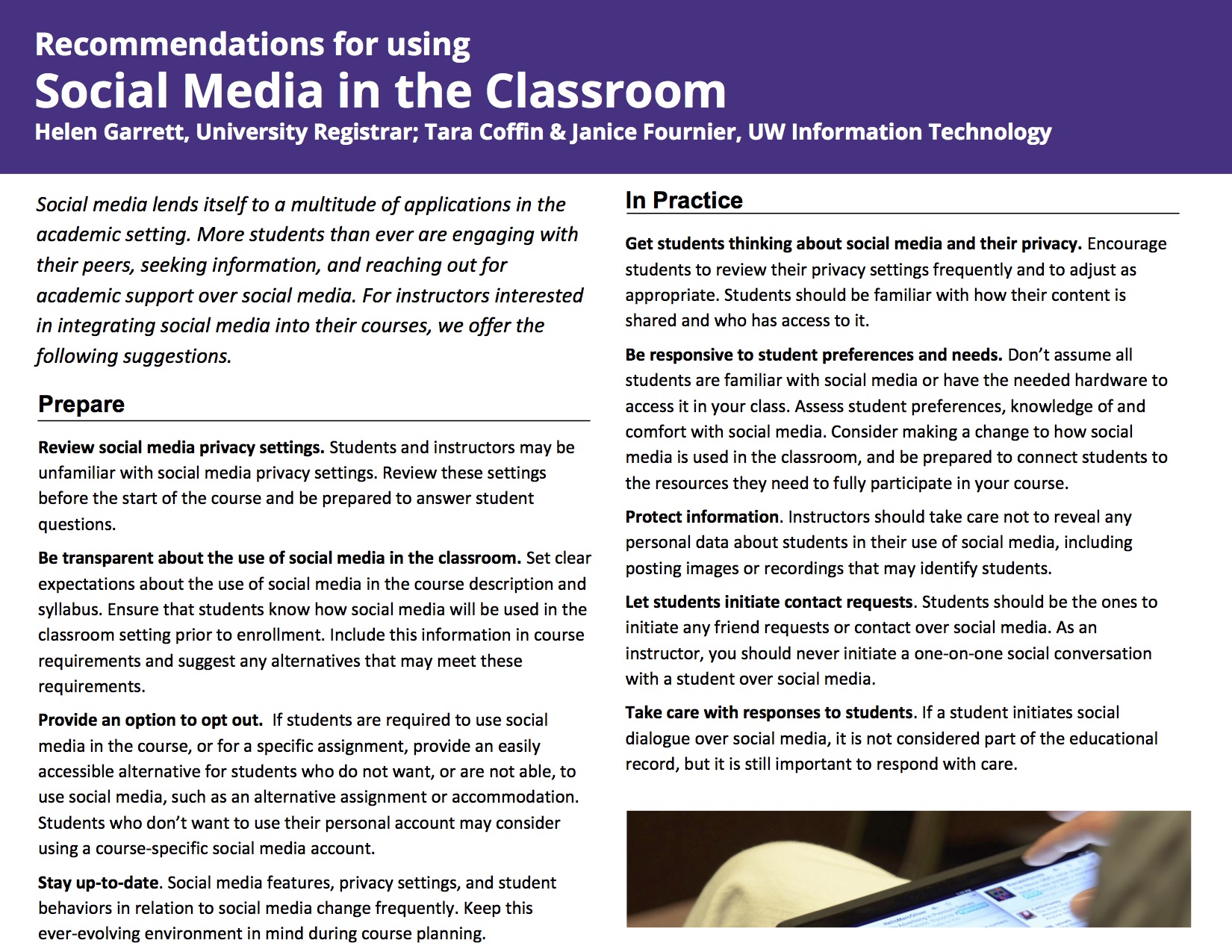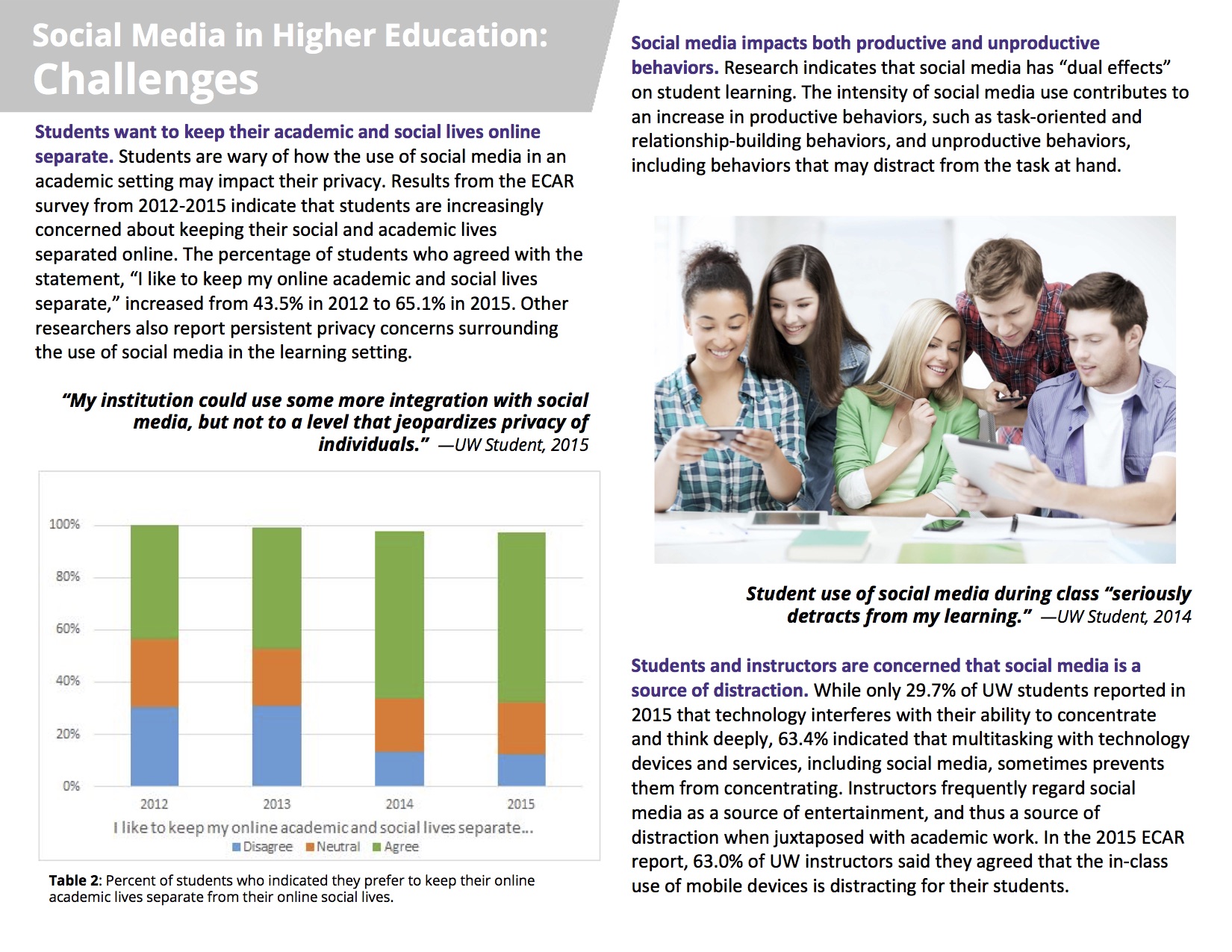- On This Page
- Overview
- Opportunities & Challenges with Social Media
- Recommendations for Using Social Media in the Classroom
- Social Media FAQ
Overview
The EDUCAUSE Center for Analysis and Research (ECAR) conducts an annual survey of over 250 institutions of higher education, including the University of Washington, examining the technology experiences of undergraduates and faculty. A recent ECAR survey included questions exploring faculty and student perceptions of and experiences with social media as an academic resource. While the ECAR findings raise more questions than they answer, there is significant evidence that UW faculty and students are interested in the potential utility of social media as a learning tool. Read on for to learn about opportunities and challenges with social media in the classroom as well as recommendations, authored in consultation with the University Registrar, for incorporating the use of social media in academic work.
Opportunities & Challenges with Social Media
View/Download a PDF version

Recommendations for Using Social Media in the Classroom
Considering both the potential opportunities and challenges in using social media as an educational tool, UW instructors should take steps to ensure successful adoption in the classroom. Fortunately, best practices and guidelines can help set appropriate expectations for using social media in teaching and learning. These recommendations, created in consultation with the University Registrar, address actions that can be taken by instructors.
View/Download a PDF version

Social Media FAQ
What is social media?
Social media is a communication tool that allows users to interact with, and contribute to, content online. It includes popular online social networks such as Pinterest, Twitter, Instagram, YouTube, and Facebook, with new platforms emerging. Although social media has a large presence in news and entertainment, when used in the learning setting for educational purposes it has the potential to facilitate communication, augmenting the student experience and improving outcomes, by:
- Encouraging interaction and engagement among students
- Nurturing a student-centric learning setting
- Extending the learning environment beyond the classroom
- Facilitating the flow of information between students, faculty, and the campus community
Why would I use social media in my teaching?
Current research suggests that in the higher education setting, social media may be used to improve communication between students, instructors, and the surrounding campus community. While many different types of communication tools are available in the learning setting, the advantage of using popular social media platforms is that most students arrive to campus as fluent users of these virtual tools. Whether or not instructors adopt social media as an education tool, chances are their students already have created a class-specific Facebook group, use Twitter to share course information, or use another social media platform to communicate with other students outside of class.
Do I need to be concerned about privacy?
It’s best to view anything posted to social media as publicly available information, and treat content accordingly. While many social media platforms, such as Facebook, provide users with the ability to filter who is able to see their content, it is difficult to ensure privacy. Once posted, social media content is held by a third party, and the user more or less relinquishes ownership in exchange for free storage.
What can I do to protect my privacy?
Instructors and students should familiarize themselves with social media platform-specific privacy settings, and stay up-to-date with them. Many social media platforms enable the user to determine how widely their content is shared, restricting access to a designated group or making content publicly accessible. While these settings offer some degree of protection, there’s no guarantee that anything posted to a social media platform is actually private, so best practice is to treat any posts as public.
Some students and instructors might prefer to compartmentalize their online social and academic lives by creating separate accounts for coursework. Over Twitter for example, instructors can offer students access to a shared class account, using a handle or username associated with the course itself, e.g. @Bio101. In this case, students would all have access to the same account, utilizing this account to contribute to discussion and post content. Over Facebook, instructors and students may opt to create a group or page specific for class. While these social media groups can be set to “private” or “secret,” enabling instructors and students to control who has access to them, instructors should continue to collaborate with their colleagues, TAs, and students for ideas on preserving privacy.
What should I do to protect student privacy?
In addition to the above recommendations, instructors need to be mindful of what type of content they post to and about their students. Posts should not include any personal data about students, including images, recordings, or any documentation related to a student’s performance in class.
Protecting student privacy also means that instructors model positive social media practices and privacy considerations in class. When using social media for a class-related activity, instructors should talk to their students about social media and privacy, and encourage students to keep themselves up-to-date with changing privacy policies.
How should I communicate how social media will be used in the classroom, to my students?
However you choose to communicate expectations about how social media will be used in the course, it is essential to make students aware of these expectations as early as possible, equipping students with the information they need to make informed choices about their course schedule. Instructors may opt to clarify expectations in the course description, so students are aware even before enrollment. Such expectations can also be detailed in an accessible course Canvas page, over MyPlan, or in course marketing materials. Students should have a clear idea about how social media is used, if it is required, and what, if any, accommodations or alternative assignments are available.
What are some ways I can use social media in my courses?
One way to begin integrating social media into the classroom is to ask other instructors, TAs or students what they are doing. In addition to these sources, here are some ideas for ways instructors can use social media as a teaching and learning tool:
- Use Twitter to hold a real-time course discussions that include remote learners.
- Encourage students to create course-specific, virtual study groups over social media. This enables students to share information about upcoming assignments, coordinate in-person student groups, or comment privately about course related issues.
- Complete a collaborative assignment over social media.
- Connect with other students or campus organizations over Facebook to learn about co-curricular activities.
- Keeping remote collect students connected: Virtual student unions provide communities for online learners
- Stay informed about a variety of campus events by following specific campus groups over Facebook or Twitter.
- Facilitate a class discussion over social media in place of an LMS discussion board (e.g. Canvas discussion board), posting questions on a course specific social media account, inviting students to respond to the prompt, and add to the conversation.
- Create an assignment that requires students to connect with social media content to complete.
- Hold office hours over social media.
- Disseminate research findings and course information through a popular social media platform.

